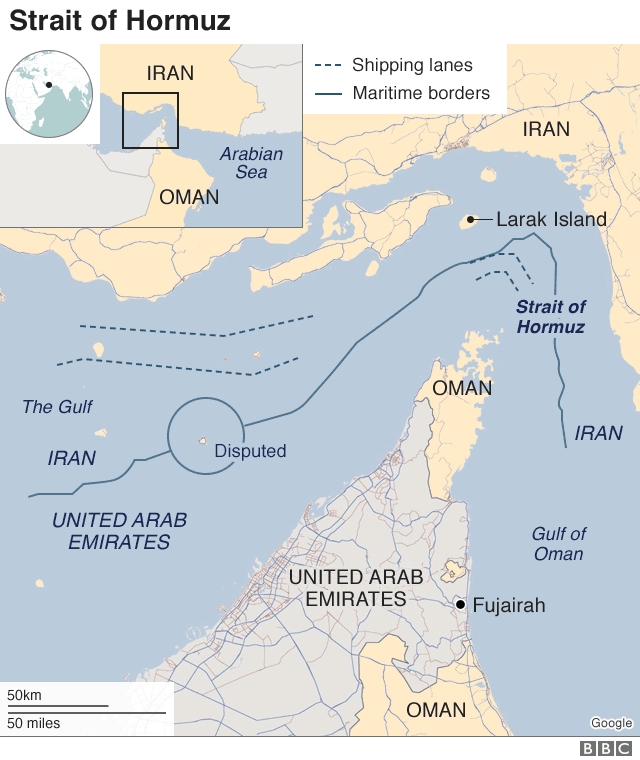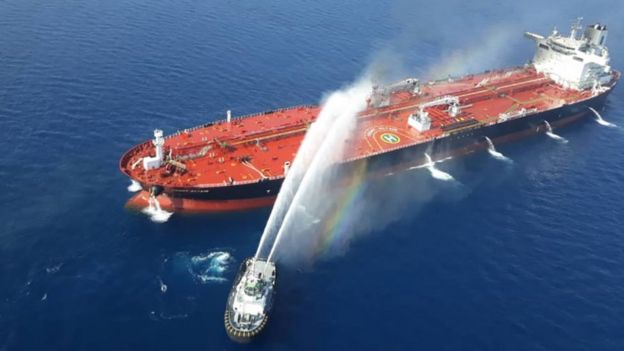
The Strait of Hormuz, a narrow shipping route in the Gulf region, is at the centre of rising tensions after Iran seized a British-flagged tanker there.
So, what is the waterway and why does it matter?
Despite its small size, the Strait of Hormuz is one of the world's most important shipping routes.
It is about 96 miles long and only 21 miles wide at its narrowest point, with shipping lanes in each direction just two miles wide.
Bounded to the north by Iran and to the south by Oman and the United Arab Emirates (UAE), the Strait of Hormuz connects the Gulf with the Arabian Sea.

The strait is deep enough for the world's biggest crude oil tankers, and is used by the major oil and gas producers in the Middle East - and their customers.
At any one time, there are several dozen tankers on their way to or leaving the Strait of Hormuz.
About a fifth of the world's oil - nearly 21 million barrels a day - passed through the Strait of Hormuz last year.
That is slightly more than went through the the Strait of Malacca, a major international waterway in the Indian Ocean.
And it is a lot more than goes via the Suez Canal, Bab el-Mandeb in the Red Sea, or the straits that separate Turkey from mainland Europe.
The Strait of Hormuz is vital for the main oil exporters in the Gulf region, whose economies are built around oil and gas production.
In 2018, Saudi Arabia sent nearly 6.4 million barrels of oil per day via the strait, while Iraq sent more than 3.4 million, the UAE nearly 2.7 million and Kuwait just over two million.
Iran also relies heavily on this route for its oil exports.
And Qatar, the biggest global producer of liquefied natural gas (LNG), exports nearly all its gas through the strait.
Main destinations
It has become particularly important in recent years for the major economies in Asia.
Most of the oil going through the strait in 2018 went to China, Japan, South Korea and India. And the US also imported nearly 1.4 million barrels a day via this route.
The UK does import some oil from the Gulf via the Strait of Hormuz, as well as around a third of its liquefied natural gas.
The Strait of Hormuz is still the best route for transporting large volumes of oil out of the Gulf and is the only route by sea.
There are some land-based pipelines that can carry oil.
A Saudi pipeline goes to the Red Sea, and has a capacity of about five million barrels of oil a day.

There've been a number of attacks on tankers
Abu Dhabi has a pipeline that can carry about 1.5 million barrels of oil a day down the coast, to beyond the Strait of Hormuz. And there is a pipeline that can transport Iraq's oil to the Mediterranean coast.
But not all these pipelines are working at full capacity.
And they cannot transport nearly as much oil as can be carried by ship.
UN rules allow countries to exercise control up to 12 nautical miles (13.8 miles) from their coastline.
This means that at its narrowest point, the strait and its shipping lanes lie entirely within Iran and Oman's territorial waters.
However, international conventions give ships - including military vessels - the right of passage through a state's territorial waters.
Iran is allowed to act in its own territorial waters - but not at the expense of the right of passage for foreign ships.
The US has now beefed up its military presence in the region. But it has also said it is keen for other countries to play a part in safeguarding the Gulf and wider region.
And the UK has announced that it is providing a naval escort for British-flagged ships passing through the Strait of Hormuz.